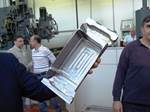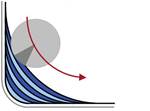A 50-Taper Machine Is A Better Fit Than You Think
Go deeper? Shops often fail to realize what good candidates they are for a heavier and more rigid machining center.
When the Boeing Research and Technology group talks to shops about how to machine titanium more effectively, members of the group talk about tool paths, tool parameters and tooling techniques—but they also talk about tool costs. One of the articles in the study of titanium among the articles under “Editor Picks” at right discusses these very costs. Sticking with a cheap tool is likely to be a false economy, because the tool that forces a shop to slow down or make frequent tool changes might cost more in lost output than what the shop is able to save on the tool price. Many shops that have looked seriously at their production costs have come to precisely this conclusion.
Yet some of these same shops have a similar false economy still present in the process—lurking at a higher level of investment.
Sandvik Coromant’s Bruce Carter has seen it. He offers some tips on machining titanium that also appear within the series of articles at right. As we were talking about machining this metal, he mentioned some mistakes he sees shops frequently make in this application. As you might expect with titanium, the most common mistake he sees is not using enough coolant. However, he says the second most common mistake is using too little power to cut this metal when a heavier machine could easily be justified. Specifically, shops frequently accept and stick with a 40-taper machine for work that a 50-taper machine might be able to do much more productively.
Think about it—you may be investing in the cutting tools that let you do all you can with your machining center, but are you stopping there? Are you accepting the limits of what your current machining center can do?
The false economy of a lower-performance machine tool follows almost the same logic as that of a lower-performance cutting tool. If it is possible to cut deeper and faster, and if you would profit by cutting deeper and faster, then you are losing money by not cutting deeper and faster. This loss is potentially large enough that it could make the incremental extra cost of a more forceful machine look quite small by comparison.
The statement in the headline above is not true of every shop, but the proportion of shops for which it is true has grown. Machining has entered a “heavy metal” phase in recent years. Aircraft, power generation, oilfield work and other industries have all seen increased demand for machined titanium or steel. Do you continue to assume that a machining center in your shop has to be 40-taper or smaller, imagining that bigger machines belong somewhere else? If your own mix of machining work is getting harder, then maybe it’s time for one of your machines to be heavier.

.jpg;width=70;height=70;mode=crop)









.png;maxWidth=300;quality=90)

